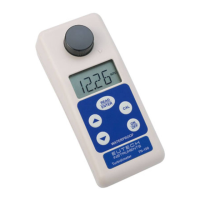Instruction Manual TN-100/ T-100
23
9.6 Calibration
1. Do not open the vials with calibration standards.
2. Check that the standards have not expired.
3. Make sure the calibration vials are free of dust, smudges and scratches before
use.
4. Conduct the calibration in the same manner each time. Variations in how
calibration is performed could yield inaccurate measurements.
5. It is very important that the user(s) who perform calibration have been trained to
do so. Creating a Standard Operating Procedure (SOP) for the user(s) to read,
learn, and practice may help to ensure accuracy.
9.7 Dilution
This dilution procedure is necessary only when your turbidity measurement is
above 1000 NTU.
1. To measure the turbidity above 1000 NTU, dilute the sample with turbidity-free
water.
2. Turbidity-free water can be obtained by filtering deionized water through a <
0.2μm filter membrane with precision-sized pores.
3. Measure the volume of the sample before dilution and record the value in ml
(Vs).
4. Take a known volume (Vd) of dilution water and add it to the sample.
5. Pour 10 ml of the diluted sample in a clean vial and measure the turbidity of the
diluted sample. Record this value in NTU (Td).
6. Calculate the true turbidity (T) of the original sample - in NTU - using the
following formula:
T = Td * (Vs + Vd) / Vs
Example:
Dilute 20 ml of the original sample (whose turbidity is above
1000NTU) with 50 ml of dilution water.
Measure the turbidity of the diluted sample.
If the reading is 300 NTU, the turbidity of the original sample is 1050
NTU. (In this case: Td=300NTU, Vs=20ml, Vd=50ml, so T = 300 *
(20+50) / 20 = 300*70/20 = 21000/20 = 1050)

